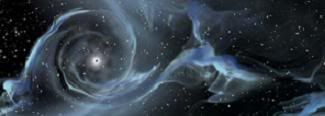Post by glactus on Mar 17, 2008 19:48:34 GMT

Primordial black holes are remnants of the Big Bang and they are predicted to be knocking around in our universe right now. If they were 10 to the power of 12kg or bigger at the time of creation, they have enough mass to have survived constant evaporation from Hawking radiation over the 14 billion years since the beginning of the cosmos.
But what happens when the tiny black hole evaporates so small that it becomes so tightly wrapped around the structure of a fifth dimension (other than the "normal" three spatial dimensions and one time dimension)?
Well, the black hole will explosively show itself, much like an elastic band snapping, emitting energy. These final moments will signify that the primordial black hole has died. What makes this exciting is that researchers believe they can detect these events as spikes of radio wave emissions and the hunt has already begun…
Some primordial black hole antics include kicking around asteroids if they pass through the solar system, blasting through the Earth at high velocity, or even getting stuck inside a planet, slowly eating up material like a planetary parasite. How are we ever going to observe these theoretical singularities?
Now, the ultimate observatory has been realized. The Eight-meter-wavelength Transient Array is currently taking high cadence radio wave observations and has been doing so for the past few months, giving researchers a unique opportunity to see primordial black holes as they die.
Interestingly, if their predictions are correct, this could provide evidence for the existence of a fifth dimension, a dimension operating at scales of billionths of a nanometer. If this exotic emission can be received, and if it is corroborated by both antennae, this could be evidence of the string theory prediction that there are more dimensions than the four we currently understand.

NGC 3242
credits:
This is part text only. See Black Hole image, full text and all scientists involved at universetoday.com
www.universetoday.com/2008/03/16/when-black-holes-explode-measuring-the-emission-from-the-fifth-dimension/#more-13190
Article credit Ian O'neill



